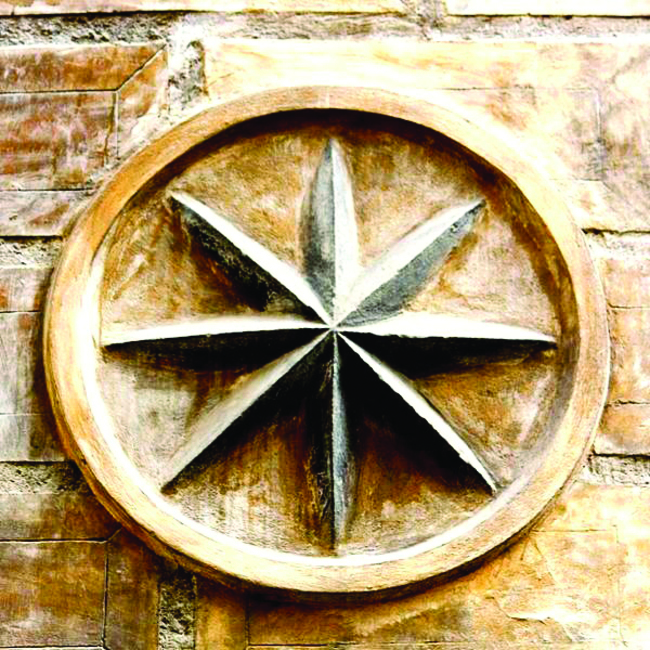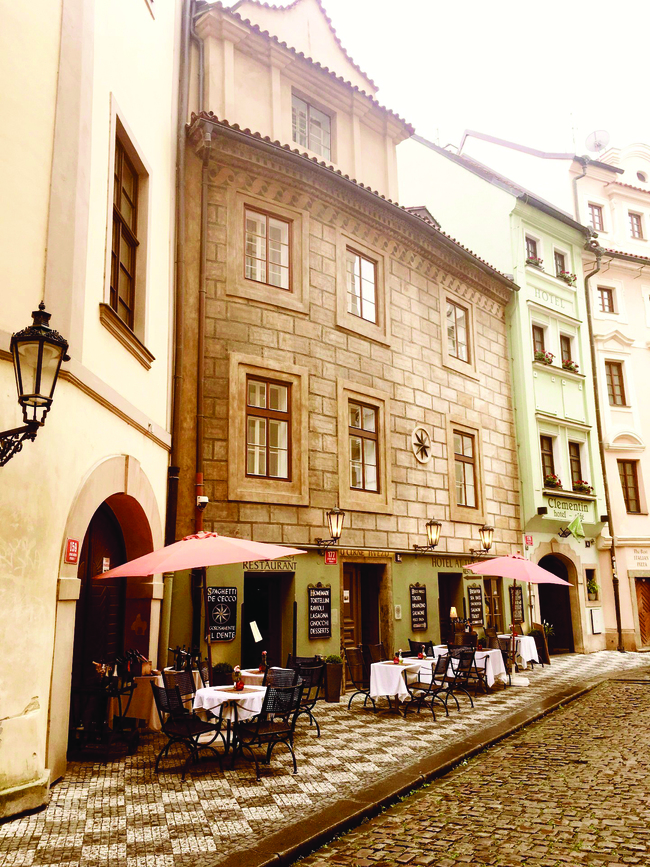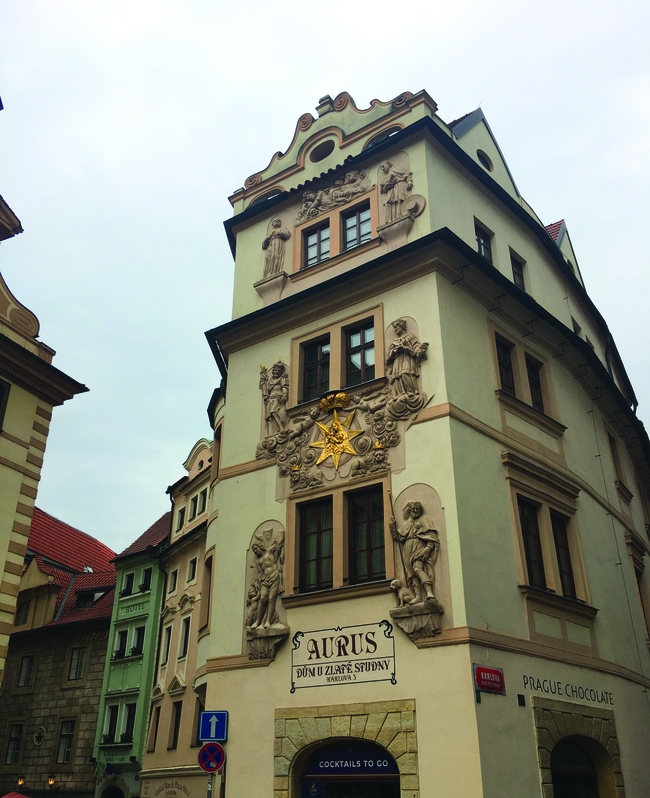We meet Gianni Baylo, a pioneer of Italian entrepreneurship in the Czech Republic, who tells us the secrets and legends of a street with hidden charms
Discovering Seminářská and its Black Star
by Sabrina Salomoni
On the route between Charles Bridge and Old Town Square there is a street on the left that many will have seen, perhaps without noticing or remembering its name. It is a rather narrow and short street lined with tall old buildings. It is called Seminářská Street and it connects Mariánské Square, where the New Town Hall and the Municipal Library are located, and Karlova Street, where in past centuries the procession from the city centre across Charles Bridge to the Castle for the solemn coronation ceremony of Bohemian monarchs, the so-called Royal Route, used to take place.
It is precisely on Seminářská that we sit for a coffee, in front of the “At the Black Star” restaurant. We are guests of Gianni Baylo, a pioneer of Italian entrepreneurship in Prague and a great lover of art, music and culture in all its forms. The location is no coincidence, as for decades Baylo has owned one of his most iconic buildings, the ‘dům U Černé hvězdy’ (the house at the Black Star), at No. 6 of this street. The building, listed as a UNESCO World Heritage Site, now houses the romantic flats of the ‘Hotel At the Black Star’.
“When I discovered Seminářská Street, I was fascinated,” he tells us. “It is a street that exudes mystery and magic, taking you back in time. You still seem to see the merchants’ caravans that passed through here on their way to the Vltava, when these streets were full of lively markets, houses and courtyards. And in the bowels of the houses you could find hidden mysterious cellars’.
Seminářská Street came into existence around the middle of the 16th century when the Klementinum, the huge building complex that had housed the Jesuits since 1556, was built. After the abolition of the Jesuit college in 1773, part of Charles University in Prague with the Imperial Library and the general seminary founded by Joseph II for Bohemia, which became an archiepiscopal seminary in 1790, were established in the Klementinum. It was to the latter institution that we owe the name Seminářská, the first written record of which dates to the end of the 18th century.
“What struck me about this palace was this black star on the façade that dates back to 1356,” Baylo continues. “According to the research I had carried out, the eight-pointed star, inscribed in a circle, represents the planet Venus, whose phases have an eight-year cycle, and is a symbol linked to female divinities from various cultures, from the Babylonian Ishtar, goddess of love and fertility, through the Egyptian Isis and the Greek Aphrodite, to the Virgin Mary. The eight-pointed star is also a sign of good luck.”
In fact, among many extraordinary Prague legends, it is said that the U Černé hvězdy house centuries ago was constantly illuminated by a strange, soft blue light, evoking terrifying tales. It was said to belong to a seamstress who had cut out her late husband’s tongue, condemned to wander forever through the alleys of the Old Town, despite her pilgrimage to Rome. At midnight, the hooves of a white horse could be heard galloping nearby, with a headless Templar riding it. The eerie atmosphere and unreal characters added to the attractiveness and romance of this enchanted corner.
Baylo, continues to share interesting facts in relation to Seminářská Street and this building, telling us that the Nobel Prize-winning poet and man of letters Jaroslav Seifert himself, in his collection of lyric poetry ‘Políbek na cestu’, does not fail to mention the house at the Black Star among the places in his beloved Prague.
In the book ‘Zlatá kaplička nad Vltavou’, a collection of short stories about Czech opera masters, author Bedřich Beneš Buchlovan, on the other hand, mentions that a tavern was in function at the Black Star in the 19th century, where the poet František Ladislav Čelakovský, the librettist Josef Krasoslav Chmelenský and the composer František Škroup, used to meet and would discuss upcoming events at the State Theatre and the operas of Mozart and Rossini, from Don Giovanni to the Barber of Seville.
“Prague was the birthplace of great musicians and composers. Being here makes me feel close to these great artists and I try to imagine what their life and work might have been like on these same streets many years ago’.
Going back to the building, the “At the Black star” house has a Gothic foundation and was first mentioned in a document dating to 1351, while in 1404 a goldsmith resided there. From other old papers, Baylo states that in 1622 the house was sold to Cyril Agricola, heir of the German Protestant theologian and playwright Johan Agricola, who rebuilt the building in the late Renaissance style. A century later it was inherited by Count Bedřich Mořic Nostic-Rieneck, field marshal and president of the court war council, and from then on the building was sometimes called ‘the little Nostic palace’. Bedřich Mořic had estates in the country where he produced wine, with which he also supplied the Black Star wine cellar. It is therefore certainly no coincidence that the restaurant’s reputation as a place to enjoy a good glass of wine is still alive today.
“I would like to emphasise, with regard to the Nostics, that we are talking about one of the oldest Czech families of lineage, whose fame and wealth date back to the period of the Battle of the White Mountain. Bedřich’s brother was František Antonín Nostic, a count and patron of the arts, animator of the social and cultural life of the time, friend of aristocrats and scholars. He had churches, villas and palaces built, mostly by the architect Antonín Haffenecker. In 1781 he contributed to the construction of the then Nostic Theatre, today the State Theatre, where the premiere of Mozart’s Don Giovanni was held on 29 October 1787, in the presence of the composer.”
The subject of music is a recurring one when talking to Gianni Baylo. “Absolutely! Music has always been a fundamental component of my life and here in Prague I have been lucky enough to immerse myself in the rich musical tradition that permeates the city. Bedřich Smetana, Antonín Dvořák and Leoš Janáček, certainly. Prague, however, also allowed me to discover great composers who, in my opinion, are somewhat forgotten: Franz Krommer, Jan Křtitel Vaňhal, Leopold Koželuh and many others, who in my opinion should be more valued, as I always say to my conductor friend, Maestro Walter Attanasi.”
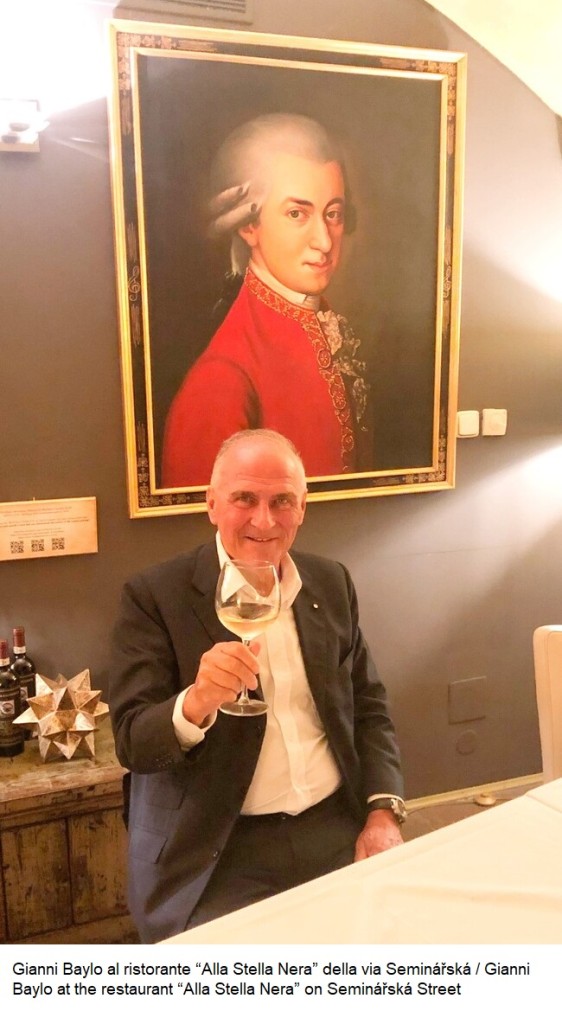
In addition to music, Baylo likes to recall his humanistic studies. “A degree in philosophy helped me develop a critical mind and deepen my understanding of the world around me. I believe this has enriched my perspective as an entrepreneur, allowing me to consider the ethical and social aspects of my decisions.”
In front of us, the Klementinum, still largely occupied by the Czech National Library, bounds the entire western side of Seminářská. On this other side of the street, there are, including the Black Star, only four house numbers, but each of them houses noteworthy old buildings whose original foundations have been preserved.
Gianni Baylo invites us to admire the beauty of the other buildings. At no. 8, the large and prestigious Trauttmansdorff Palace, a classicist building with an irregular floor plan that stretches between Seminářská and Husova Streets and Mariánské Square, a Czech cultural heritage site. The building boasts basements from the Gothic period that have been preserved since the early 15th century, the period to which the earliest mentions date back to. The most significant reconstruction took place in the late 17th and 18th centuries, according to a design by Jan Santini-Aichel. In 1840, Jan Nepomuk Trauttmansdorff decided to commercialise the building, which had been an aristocratic residence in previous centuries, and divide it into a stately part and a shop part on the ground floor. In 1951, the publisher Středočeské tiskárny was based there and in the second half of the 1970s it was taken over by the Prague Capital City Archives. Today the Trauttmansdorff palace is owned by the Pasquale family and the Czech-Italian Chamber of Commerce and Industry is based there.
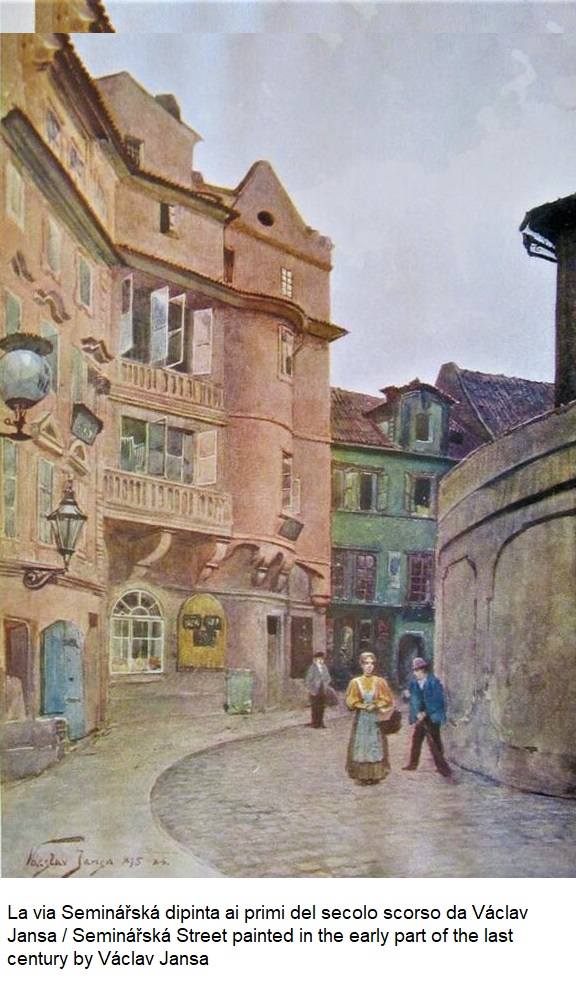
At the opposite end of the street, at number 2, is the house “At the Golden Well.” The name is the result of a legend, as the well’s water was said to be so pure that it concealed a treasure at the bottom. Some sources claim that the treasure was actually found during a cleaning of the well. In the past, the house was also called “At the Red Chair” probably because the Italian cardinal and apostolic nuncio Filippo Spinelli lived there. Originally in the Romanesque style, the palace was adapted in the Gothic period and in the early 17th century it was radically renovated in the late Renaissance style. The three floors are best known for the 18th century frescoes by Jan Oldřich Mayer depicting St Wenceslas and St John of Nepomuk, the patron saints who protected the people of Prague from the plague, St Sebastian and St Roch and St Rosalie, and the Jesuit patron saints St Ignatius and St Francis Borgia. Under the windows of the second floor is a golden medallion, an eight-pointed star with the image of the Virgin Mary of Stará Boleslav with the infant Jesus in the centre. This building is also today the site of a hotel.
The adjacent building at number 4 is the House of the Virgin Mary, which dates back to 1360. Today it houses the narrowest hotel in Prague, the Hotel Clementin. The width of the building is only 3.28 metres and the entrance is framed by a Baroque sandstone portal. The oldest part is the Gothic basement with massive walls and the remains of a stone vault from the Middle Ages.
We would like to thank Gianni Baylo for helping us learn more about this charming street in Prague, with its secrets and ancient legends that still echo on Seminářská today. The hubbub of tourists here seems distant, and one rather feels as if you can hear the clattering of the valiant knights of yesteryear on the pavement.





